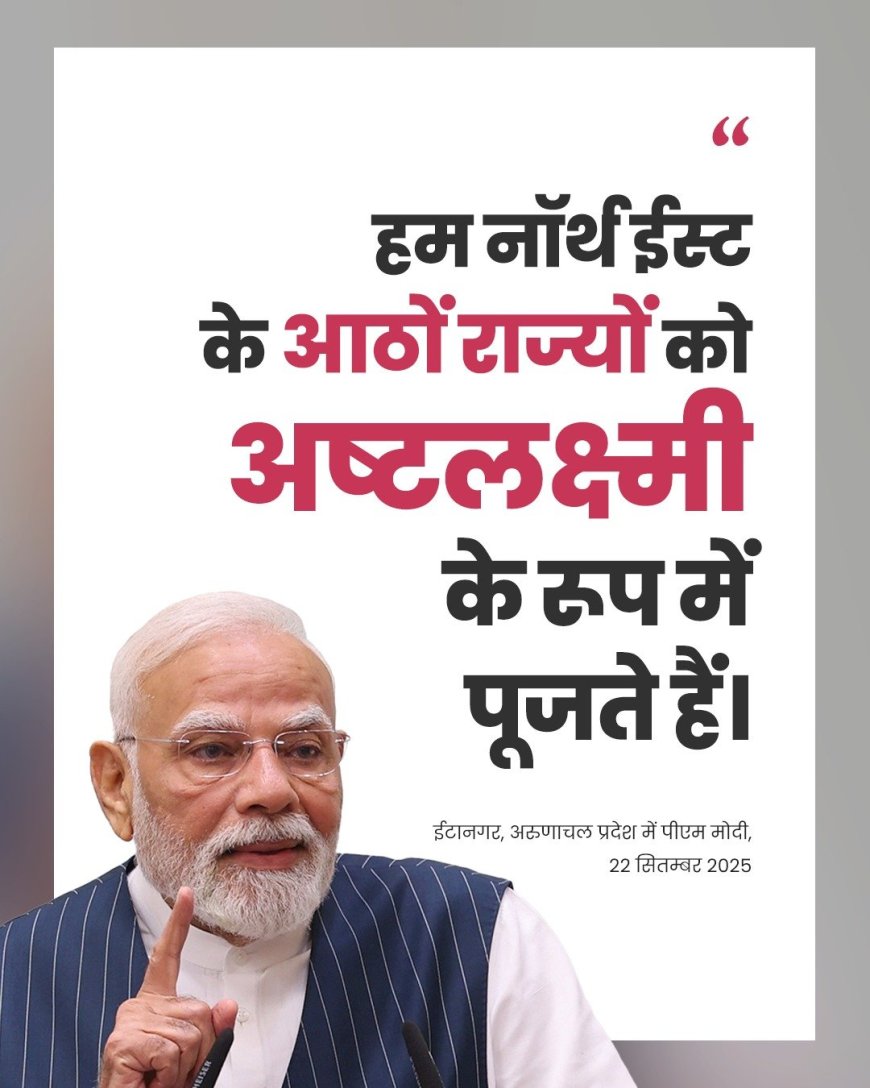Prime Minister Narendra Modi Launches Rs 5,100 Crore Projects and GST Reforms in Arunachal Pradesh
PM Modi unveils ₹5,100 crore projects & GST reforms in Arunachal Pradesh to boost growth, connectivity & ease of living.

Introduction
On 22 September 2025, Prime Minister Narendra Modi laid the foundation stone and inaugurated multiple development projects worth more than ₹5,100 crore in Itanagar, Arunachal Pradesh, while also rolling out the new GST 2.0 reforms nationwide. The twin announcements—massive infrastructure investment and simplified taxation—are intended to accelerate development, especially in the Northeast, improve ease of living, boost local economies, and bring relief to citizens via reduced tax burdens.
History & Background
-
Arunachal Pradesh, being one of India’s northeastern states, has for decades faced challenges like difficult terrain, limited infrastructure, less connectivity, and fewer economic opportunities compared to many other parts of India.
-
Since 2014, the BJP-led NDA government has often emphasized development of the Northeast—through schemes like “Vibrant Villages Programme”, improved connectivity, investment, and lastly through recurrent visits by centre ministers and PM.
-
GST reforms have also been in discussion for months: the 56th GST Council meeting recently simplified rate slabs from four to two (5% and 18%) for most items; some items are now exempt or in lower rate categories.
What Exactly Was Announced & Region Behind It
Where / When
-
Location: Itanagar, Arunachal Pradesh
-
Date: 22 September 2025
What Projects
-
Two large hydroelectric power projects were initiated: the Heo (240 MW) and Tato-I (186 MW) in the Siyom (Shi-Yomi) sub-basin.
-
A state-of-the-art Convention Centre in Tawang, capacity ~1,500 delegates, for cultural festivals, exhibitions etc.
-
Additional infrastructure projects (≈10 more) worth ~ ₹1,290 crore, covering connectivity, health, working women hostels, fire safety, etc.
GST Reforms
-
Simplification of GST slabs: reduction to two main slabs (5% & 18%) for most goods and services.
-
Many items (essentials, clothing, footwear, educational materials etc.) have become cheaper or exempted. A “GST Savings Festival” is underway to highlight the benefits.
Why Arunachal Pradesh? Why This Timing?
-
Strategic Symbolism: Arunachal is known as “land of first rays of the sun” and often used symbolically for bridging national integration and inclusive growth. Modi emphasized that development must reach even frontier and border areas.
-
Neglect Addressed: PM criticised earlier regimes for neglecting Northeast and Arunachal especially, citing that despite its natural potential, infrastructure & connectivity were weak. This event builds on fulfilling promises.
-
GST Reforms Roll-out Across India: Because the new GST slabs came into effect nationwide on that date, PM chose Arunachal to launch as part of the broader “next-generation GST reforms”. That gives the region high visibility.
Key Points & Latest Updates
-
The total value of announced projects is over ₹5,100 crore. Among them, hydro power projects alone cost around ₹3,700 crore.
-
The GST council has cut rates on around 375 items, simplified slabs, making many essentials more affordable.
-
PM also interacted with local traders, shopkeepers in Itanagar to explain GST changes and held “GST Bachat Utsav” (Savings Festival).
Advantages / Positives
-
Reduced Tax Burden: Consumers will save money on many everyday goods, boosting disposable income.
-
Boost for Local Economy: Infrastructure projects will create jobs, improve connectivity, power supply, health facilities etc.
-
Attraction for Tourism: Convention centre, improved connectivity can help tourism in Tawang and other scenic parts of Arunachal.
-
Ease of Doing Business: Simplified tax structure, fewer slabs, simplified compliance helps small traders, MSMEs.
-
Strategic Development & Inclusion: Frontier and remote districts getting better attention; border and hill areas often underserved.
Drawbacks / Risks / Challenges
-
Implementation Bottlenecks: Even with announcements, difficult terrain, environmental clearances, land acquisition could delay hydropower / connectivity projects.
-
Cost Overruns: Large power projects often run into delays and increased costs—budget escalation could happen.
-
Environmental & Social Concerns: Hydropower projects may affect river ecology, tribal lands, wildlife; displacement or ecological risk is real.
-
GST Implementation Hiccups: Though rate changes are positive, small traders may face confusion in adapting; supply chains & pricing transitions may cause anomalies.
-
Revenue Trade-Offs for States: While central GST reforms may reduce taxes, states giving up or modifying VAT / other taxes might lose some revenue, unless compensated well.
Significance & Broader Implications
-
Marks a phase where the Northeast is central in national planning, not periphery. Sets precedent for transparent, visible infrastructure investment in border states.
-
Shows GST reforms are being tied to festival season and consumer benefit campaigns (“Bachat Utsav”) to make policy feel relevant to everyday people.
-
Reinforces narrative of “Nation First”, and potentially improves political goodwill for central government in remote areas.
Final Thoughts & Conclusion
The Rs 5,100 crore package of projects in Arunachal coupled with sweeping GST reforms is an ambitious move that aims to combine infrastructure development with tax relief. It represents both symbolic and material gains—bringing promise of power, connectivity, tourism, and ease of doing business, while also cutting costs for consumers.
However, as with all big announcements, the ultimate impact will depend on execution: project completion, environmental safeguards, local participation, and smooth transition under GST. If these work well, Arunachal could see real transformation. But if delays, cost overruns or implementation gaps crop up, much of the potential could be curtailed.
Overall, the move looks positive, particularly for Northeast India. It’s a step toward more inclusive growth, giving visibility and investment to places that have long been marginalised. For citizens, it could mean better services and more affordable goods. For the government, it's a test of translating promises into results.

 Ellofacts
Ellofacts 





